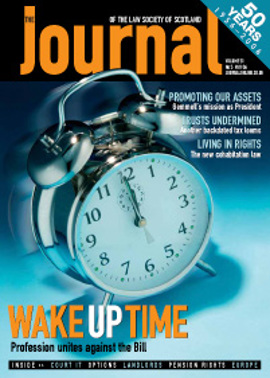Book reviews

A Mixed Legal System in Transition
T B SMITH AND THE PROGRESS OF SCOTS LAW
EDINBURGH STUDIES IN LAW VOLUME 1
EDITORS: ELSPETH REID AND DAVID CAREY MILLER
PUBLISHER: EDINBURGH UNIVERSITY PRESS
ISBN: 0 7486 2335 3
PRICE: £45
Until his death in 1988, Professor Sir Thomas Broun Smith bestrode the Scottish legal academy like a colossus. Undoubtedly the most famous Scots legal academic of his generation, his scholarship was known and respected throughout the world. This was a position of which “TB” was not only aware but greatly enjoyed. Indeed, much of the acclaim arose not only from his intellectual prowess but also from his hugely charismatic personality.
Yet his purpose was not self aggrandisement. He was charged with a mission to preserve and further the development of Scots law as a mixed legal system, and particularly to re-emphasise its Civilian roots. To do so, Scots lawyers had to perform on an international, as well as national, stage: TB did so with relish. By emphasising the unique nature of Scots law in an international arena, he hoped to diminish the prospect of Scots private law being overwhelmed by rules indiscriminately transplanted from the English common law.
The essays in this book – most delivered as papers at a conference held in Aberdeen to celebrate the anniversary of his birth in 1915 – explore his work and legacy. In an honest and perceptive piece, Kenneth Reid argues that at one level Smith was a failure. There has been no Civilian revolution, there is no school of dedicated disciples and much of his scholarship, in particular A Short Commentary on the Law of Scotland, is no longer read. Yet the current vibrancy of Scots law owes much to TB’s vision. The foundation of the Scottish Universities Law Institute has led to the publication of modern treatises on Scots law and indirectly to a general renaissance in Scottish legal scholarship. The Stair Memorial Encyclopaedia, of which TB was the first general editor, has become a major source of the law. The Scottish Law Commission, of which TB was one of the first commissioners, has played an important role in developing Scots law as a modern legal system – though often not on the Civilian lines envisaged by Smith. Scots lawyers have their seat on international legal commissions and are in the thick of comparative law projects, particularly at the European level and with other mixed legal jurisdictions. In short, Scots law and Scots lawyers are taken seriously in a way that would have been impossible without the immense contribution of TB.
All the essays are interesting and well written: TB who loved language would have been delighted. Alas, space does not permit discussion of all of them in this review. Some appear slightly tangential to the theme: for example, Erich Schanze on the recognition principle in European law. Others treat of an area of substantive law from a “Smithian” perspective: for example, Elspeth Reid’s excellent study of aemulatio vicini. John Blackie’s contribution on TB as legal historian is an elegant apologia for the fact that he wasn’t particularly good, at least if judged by contemporary criteria. In his essay on Smith as a pioneer of modern medical jurisprudence, David Meyers does not cite a case from the Rota, beloved by TB, of the impotent Roman who sought to buy the testicles of a young, virile Neapolitan!
I greatly enjoyed Daniel Fischer on Smith as a comparative lawyer. Fischer sees Smith as a forerunner of those who emphasise – and joy in – the differences between legal cultures, though Smith would accept some harmonisation of laws but only after careful study of Civilian as well as Anglo-American solutions. Niall Whitty takes the opportunity to reject the introduction into Scots law of a supplementary jurisdiction in equity: however, the threat of such a development seems to the present writer to be very much overstated.
In the first of his two contributions, Hector MacQueen unravels the relationship – or better perhaps, non-relationship – between Smith and Lord Cooper of Culross. Although TB hailed Cooper as his intellectual mentor, MacQueen carefully shows how it was TB who built upon and fleshed out Cooper’s naïve, if seminal, ideas of the importance of the law – and its Civilian roots – in the development and sustenance of a Scottish national identity. The men were never close.
In his second paper, MacQueen assesses Smith’s contribution to the Scots law of obligations. There is no doubt that TB’s work led to academic controversy as well as important judicial developments in such areas as the ius quaesitum tertio and error. The general acceptance of the enforceability of voluntary unilateral obligations (promises) owes much to him. But the promised treatise on contract was never forthcoming and the SLC’s consultative papers on obligations did not lead to reform of the law. The latter, however, remain brilliant expositions of the law, and MacQueen should perhaps have acknowledged the immense contribution of Robert Black who drafted them when he was working at the Commission.
TB was a generalist whose interests ranged widely. But for him some areas were more interesting than others. As David Carey Miller explains, Smith was fascinated by problems relating to corporeal moveable property. His essay shows how TB over-estimated the unorthodoxy of the Sale of Goods Act’s provisions on passing of title and advocated, surprisingly, non-Civilian solutions to the question of protection of a bona fide purchaser’s title to property bought from a person who did not own the goods. This illustrates how in spite of some of the rhetoric, Smith could also be a pragmatist.
George Gretton regrets that TB was not particularly interested in commercial law, where he accepted that much of Scots law had been assimilated with English law for economic and political reasons. This is a reason why much of commercial law is reserved to the UK Parliament. Gretton also points out that Smith was not much concerned with land law and failed to notice that below the trappings of feudalism, ownership of immoveable property was also unitary as in other Civilian systems. But because of his serious, rationalist approach to the study of Scots private law, Gretton argues that Smith was an inspiration for a new generation of scholars to revolutionise our understanding of Scots property law and its reform.
As a deputy general editor of the Stair Encyclopaedia, I had the privilege and pleasure of working with TB towards the end of his life. I got to know the man as well as the scholar. He was truly remarkable. While this timely book cannot bring alive Sir Thomas Smith’s personal qualities – few of the contributors knew him well – it does make a valiant attempt to assess his contribution to the law of Scotland. Everyone who is involved in the law of Scotland, judge, academic and practitioner, owes TB an immense debt: this book explains why.
Joe Thomson
Conveyancing
AUTHORS: GEORGE L GRETTON AND KENNETH G C REID
PUBLISHER: W GREEN
ISBN: 0 414 01558 4
PRICE: £65
The third edition of Conveyancing follows the dramatic changes in conveyancing and property law brought about by the Abolition of Feudal Tenure Act 2000, the Title Conditions (Scotland) Act 2003 and the Tenements (Scotland) Act 2004. It is now difficult to place conveyancing as a separate discipline in the context of Scottish private law because these reforms are essentially about pure property law rather than the mechanics of conveyancing law and practice. Perhaps the greatest strength of the authors is their uncanny ability to place conveyancing in its proper context. As with previous editions, they adopt a straightforward chronological approach to the subject, beginning with an analysis of what conveyancing involves and then moving through a conveyancing transaction from start to finish.
The treatment of the subject is a unique blend of law and practice. This is a balance many authors often fail to strike, but Gretton and Reid have certainly achieved it. This approach is used to great effect in chapter 7 which deals with examination of title. The authors pose questions which are relevant not just to a student of conveyancing and property law but also to every practitioner. Very often practitioners do not know what defects in title are material and what defects can be ignored. This question is succinctly posed by the authors at paragraph 7-05.
Some writers are fond of posing questions which they themselves cannot answer. This criticism could never be levelled at Gretton and Reid. The authors identify the following issues:
- Do the sellers have power to convey the property?
- What are the title conditions and are they acceptable?
- Are there any securities?
- Are there searches?
- Are there any occupancy rights under the 1981 Act?
- Have the necessary planning and building consents been obtained?
The authors answer these questions (in paragraphs 7-07 to 7-09 and chapters 9, 10 and 4) clearly and with little or no legal flummery.
One of the difficulties of the old law relating to real burdens was identifying who had title to enforce. The 2003 Act contains provisions designed to identify the party with title to enforce. Some of these are transitional and have been difficult to interpret (for example, sections 52 and 53). How refreshing it is to find this difficult problem addressed clearly in seven short rules: “finding the benefited property”, at paragraph 13-15. This treatment is typical of the authors’ treatment of the subject in general. In a world where property law seems to change every five minutes it is gratifying to find someone who can transform difficult statutory provisions into readable and, more importantly, practical rules.
The book is not without humour, though some of the terminology is decidedly east coast. I refer in particular to the passage at paragraph 13-15 on survivorship destinations, in which Adam and Eve own a house in common with a survivorship destination and Adam goes off on the “razzle-dazzle” leaving Eve to cope with the house and children. Clearly we need a west coast edition where Jimmy leaves Senga and goes off on the “ran-dan”.
No solicitor’s firm should be without at least one copy of this book. It is to be much recommended.
Robert Rennie
In this issue
- Stand up to be counted
- A bill to divide us
- The pendulum swings
- The pendulum swings (1)
- Cohabitation: the new legal landscape
- The tax man cometh (again)
- The foreign legion
- Making IT happen
- Apportioning and sharing
- Property problems
- Still a profession
- Arguing over agreements
- Next generation law
- Lawyers in the transfer market
- Scottish Solicitors' Discipline Tribunal
- Landlords: setting the mark
- Website review
- Book reviews
- Purchase options in leases






